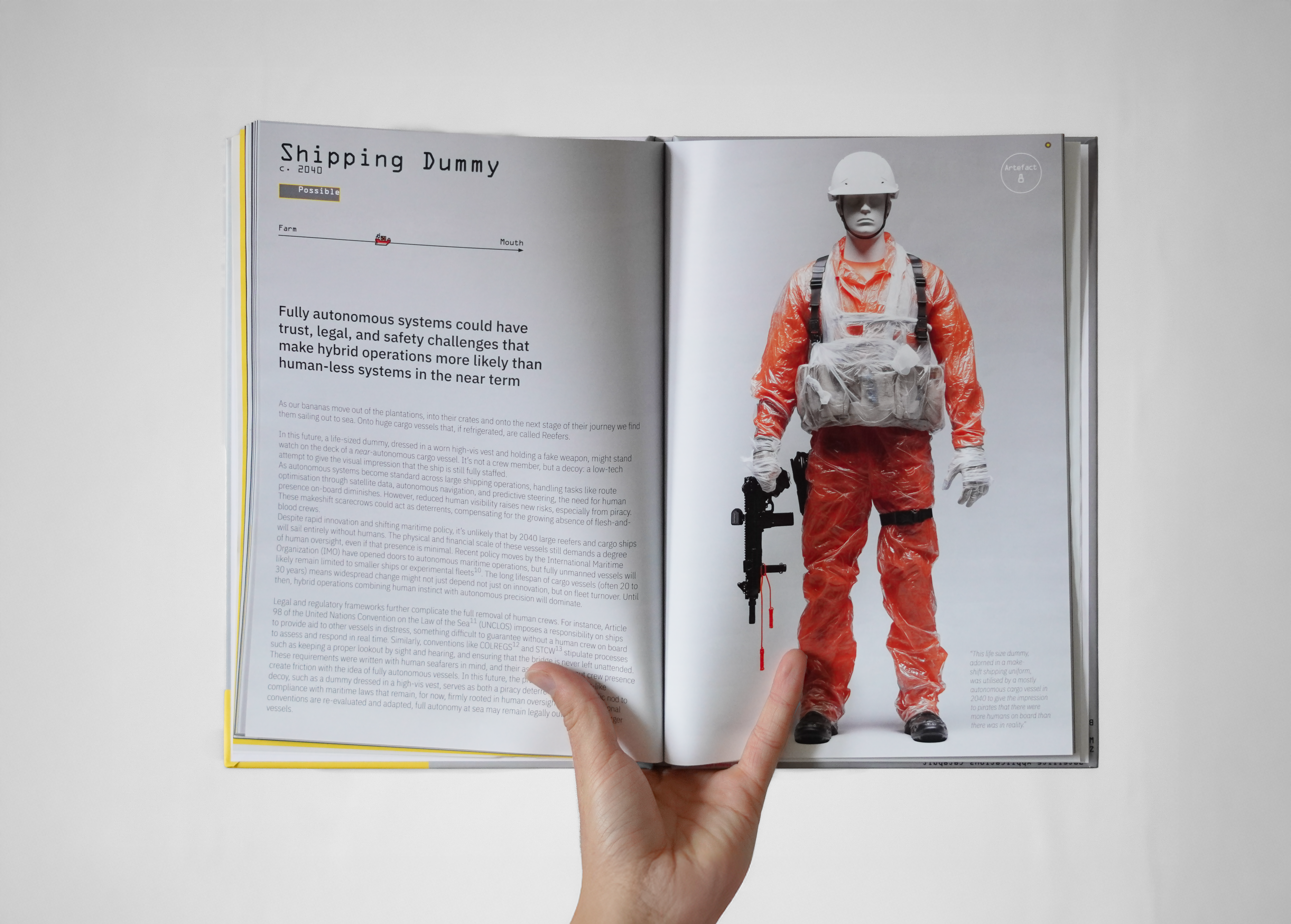November 2025
This piece was written by our SPINtern Luke Aitken who completed an 8 week placement with our User Centred Design team in summer 2025.
“We believe that by speculating more, at all levels of society, and exploring alternative scenarios, reality will become more malleable and, although the future cannot be predicted, we can help set in place today factors that will increase the probability of more desirable futures happening.”
– Anthony Dunne and Fiona Raby, ‘Speculative Everything’
“The Smart Banana & other speculative artefacts that might exist in 2040” was a Speculative Design project conducted by Luke Aitken during his time as an Intern at the Satellite Applications Catapult. The aim of the project was to take a technology complex idea within the space sector, in this case Coordinated Autonomy, and use ‘Speculative Design’ to reveal hidden systems, uncover assumptions, and spark conversations about the future.
‘But what is Speculative Design?’
Looking into the future
Speculative design is a term coined by designers Dunne & Raby in the 90’s that explores the notion of design being utilised to peer past the present, the physical and sometimes even the possible. It rejects the idea of design being a discipline restricted to directly solving aesthetic or technical problems but is instead a practice that can be used to provoke, investigate or research an area of social inquiry.
Speculative design is a tool that can be used to take complex ideas about our future and translate them into designed artefacts that help audiences understand previously inaccessible ideas and intangible concepts. These designed provocations can allow stakeholders to decide what kind of future they want, and what actions they can take today to help guide them there. The futures thinking processes involved in speculative design can also help to reveal gaps in policy, investment or innovation by uncovering the unintended consequences of technology in the future.

Example case, ‘The Future of Coordinated Autonomy’:
A project by 2025 SPINtern, Luke Aitken
‘Coordinated Autonomy’ is a term that the vast majority of the public will not have heard of, and yet it may affect society hugely in the coming decades. It describes not one technology but an entire system of autonomous technologies working together without direct human involvement. It is a technological step into the future that is enabled by space technology. Think smart ports, autonomous vehicles, drones and… bananas?
This speculative design project explores the idea that in a future of coordinated autonomy, even something as ordinary as a piece of fruit will be touched by satellites, sensors, learning and robots. The project traces one banana’s path to explore the different industries, scenarios and objects encountered on its journey.
The project follows the journey of a single banana, but it is about more than fruit. The banana is simply a stand‑in prop for countless flows of goods, data and labour. It is a simple, familiar object used to reveal a sprawling, largely invisible network of autonomous technologies and human decisions that could shape everyday life the future.
The final project output is a book. The book is an archive of 14 different objects that might exist within a bananas journey in 2040, from protest signs, smart bananas to satellite tech itself, each explores a different insight into gaps, tensions, or the huge benefits that are the consequences of space enabled technology, as well as the publics everyday decisions.
Ultimately, The book and its visual archive of future objects, aims to provoke those inside and outside of the space sector to decide if what they are seeing in the book is what they want or need from the future. It should enable stakeholders to interrogate the paths, behaviours and actions that get us there and expose gaps where innovation or investment is needed along the way.
The project invites us to look at other objects in your fruit bowl, on your desk, on your commute, and ask, how did this get here, who (or what) moved it, who benefited and who was left out?
‘So, What is the opportunity for speculative practices in the Space sector?’
Making complex ideas more accessible
Whilst this kind of provocative, subjective thinking may feel instinctively wrong in a sector guided by objective physical truths and a rigorous scientific method, I believe that the space sector can benefit from speculative design practices.
As we move forward into the future, we are critically aware that space technology will impact everyone on the planet. The space sector will become more and more prevalent in our day-to-day lives, shaping how we eat, travel, communicate and live in the future. All of our individual decisions and behaviours in the present day will influence how that future manifests.

As a society it is necessary to make sure people are aware and educated on how those decisions and behaviours can have an impact on what can seem physically or conceptually distant technologies. I believe speculative design is one tool that can be implemented to help the public and experts alike to form opinions, identify gaps and areas of tension.
The future will not simply arrive one day, it is being made now, by all of us and all of our choices.
References:
Anthony Dunne and Fiona Raby, Speculative Everything: Design, Fiction, and Social Dreaming (Cambridge, MA: MIT Press, 2013), p. 6.

